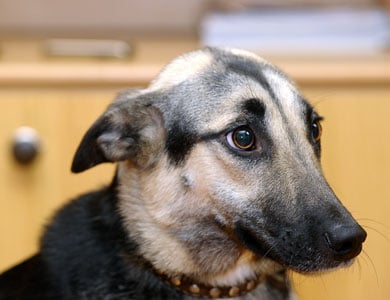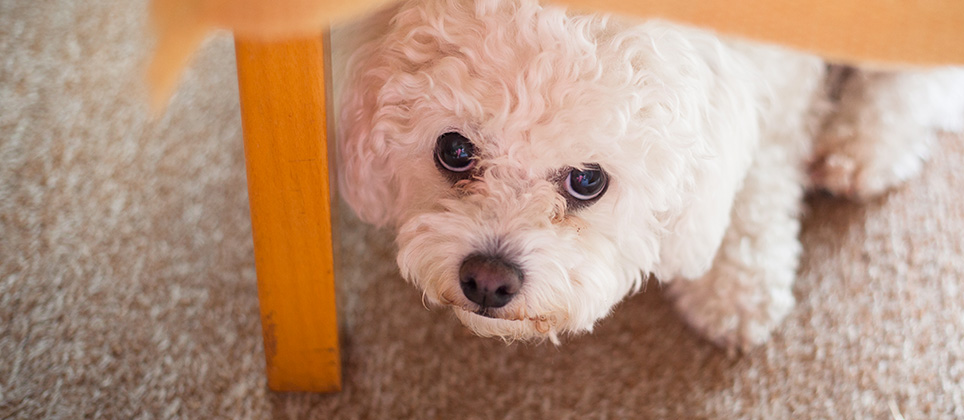Do dogs get scared? Absolutely! In fact, dogs feel a variety of emotions such as joy, sadness, anger and even fear!

Just like humans, our canine companions can experience heightened anxiety when in proximity to something they associate with danger. This is a completely normal reaction that is essential to their survival. But depending on how long the emotion lasts, this kind of fear may be considered “extreme” or “irrational”.
Unfortunately, fear can sometimes cause a dog to act aggressively… and then bite. But just because a dog is afraid does not mean they will start biting. That’s because dogs respond to fear in different ways – just like we do! Let’s take a closer look at the topic of fear in dogs.
What are dogs generally afraid of?
Depending on their past experiences, a dog can be scared of many things. For instance, they may experience anxiety in the presence of:
- People (sometimes specific kinds of people such as children)
- Noises they don’t hear very often such as thunder
- Other dogs or animals
- Cars or trucks
- Random objects such as a vacuum cleaner, a lawn mower, a garbage bin
Also read: The importance of socializing dogs
They may also feel scared in specific situations, such as:
- In spaces associated with something unpleasant (ex.: at the vet clinic they visited after a painful experience)
- When they’re in a space they don’t know or haven’t been very often
- When someone tries to approach or touch them

Why are some dogs scared while others are fine?
The answer to that question could go on for 10 pages! To boil it down in simple terms, genetics plays a part. Some fears may be encoded in their “hard drive”.
Moreover, a dog’s past experiences will also have an impact on how they respond to a situation.
How to tell when a dog is frightened
As dogs have not yet learned to speak, you need to observe their body language to better understand how they are feeling. Here are the most common signs you'll see in a scared dog.
Actions and behaviour
- They bark, whine and/or growl
- They don’t explore their surroundings, choosing instead to remain near people they know and/or seek out a human they are familiar with
- They flee and/or hide
- They avoid the source of danger and/or freeze up
- They position their head in order to avoid visual contact
- They urinate or defecate
- They refuse treats offered
- They move slowly or are constantly moving
- They lie on their back and remain stiff with their tail tucked against their belly

Head
- Their pupils are dilated
- The whites of their eyes are visible
- They look away or look at you sideways
- Their face is tense
- The skin on their forehead is wrinkled
- Their ears are pointed straight up or are flat against their head
- They breathe very quickly
- Their tongue is sticking out and the end is curved (a spatulate tongue)
- Their jaw is clenched and their lips are pursed
- They salivate
- They bare their front teeth with upturned lips, their nose is wrinkled
- They yawn and/or lick their nose frequently
Body
- Tense up
- Crouch low to the ground
- Have their tail low or tucked between their rear legs
- Have hair that is standing on end (raised hackles)
- Arch their back
- Cower
- Tremble
- Lift a paw
- Lunge, charge and/or jump
Be careful! A dog whose tail is wagging is not necessarily happy! It is a widely held belief that if a dog wags their tail, they’re happy. This is incorrect.
A wagging tail actually means that the dog is in “alert mode”. For instance, they might be reacting to seeing someone, to being near another dog, to a direct physical contact, etc. But a wagging tail doesn’t necessarily mean the dog is happy, frightened or even angry!
Also read: A dog’s tail: a useful appendage!

What can you do to help a dog who is afraid?
- Don’t force them to “confront” their fears. Instead, be gentle and progressively expose them to their fear in a pleasant way.
- Use training techniques to build communication and a relationship of trust with them.
- Don’t punish them when they act in a way you deem inadequate. This may actually heighten their fear!
- Guide them to taking the right actions and making the right decisions. Reward them when they do.
- Provide them with a quiet environment.
- Be attentive to their needs, observe and respect their emotional state. Provide them with the opportunity to hide or flee when they feel fear.
Above all, don't hesitate to ask for help. Consult your vet to make sure your dog's behaviour isn't caused by a health problem. You can also get a trusted dog educator to work with your anxious dog. This will greatly improve your dog's quality of life... and yours!
Also read: How to handle your dog’s unpredictable reactions to strangers





